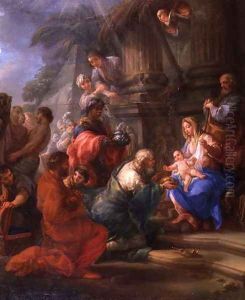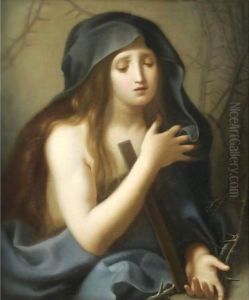Antonio Cavalucci Paintings
Antonio Cavallucci was an Italian painter born in 1752 in Sermoneta in the Lazio region of Italy. He emerged as an art figure during the Neoclassical period, a time when artists sought to return to the classical ideals of beauty and harmony from ancient Greece and Rome. Cavallucci's works are characterized by their classical themes, clear compositions, and elegant figures, often imbued with a sense of serenity and grace.
Cavallucci's initial training was under the guidance of his father, who was also a painter. Later, he studied in Rome under the guidance of Stefano Pozzi and then under the painter Gaetano Lapis. He also received instruction from the sculptor Tommaso Righi. Cavallucci's talent was recognized early on, and he gained the patronage of Cardinal Francesco Saverio de Zelada.
Throughout his career, Cavallucci was influenced by the work of other artists, including Raphael, which is evident in his use of color and his delicate approach to composition. He was also inspired by the burgeoning Neoclassical movement, adapting its principles of clarity, order, and harmony. He created numerous religious works including altarpieces and frescoes, as well as mythological and allegorical paintings which reveal his mastery of drawing and his sophisticated use of light and shadow.
One of his notable works is 'The Death of Socrates,' which reflects his ability to convey profound philosophical ideas through historical and classical subjects. Cavallucci was also known for his portraits, which capture the psychological depth and individuality of his subjects.
Unfortunately, Antonio Cavallucci's life and career were cut short when he died in 1795 at the age of 43. Despite his early death, Cavallucci's work had a lasting impact on the art of the period, and his paintings can be found in various churches in Rome and in other collections throughout Italy. His legacy is that of an artist who embodied the Neoclassical spirit through both his life and his artwork, contributing significantly to the Italian art scene of the late 18th century.

